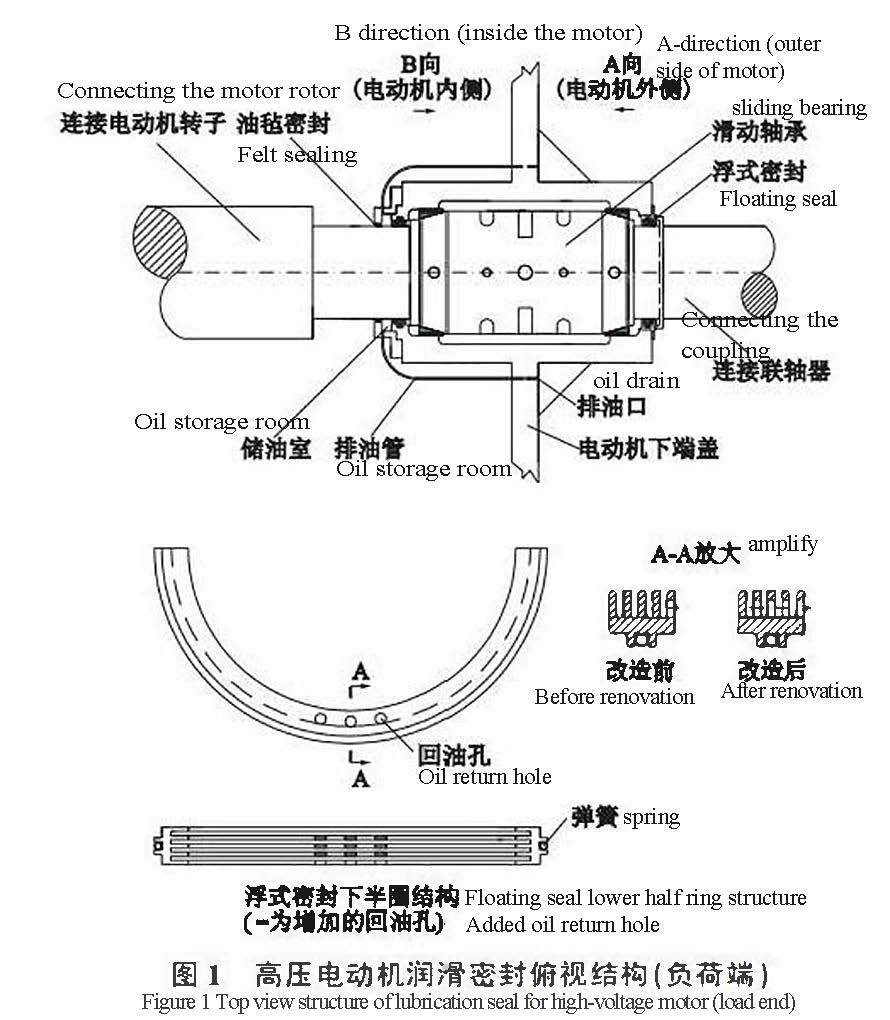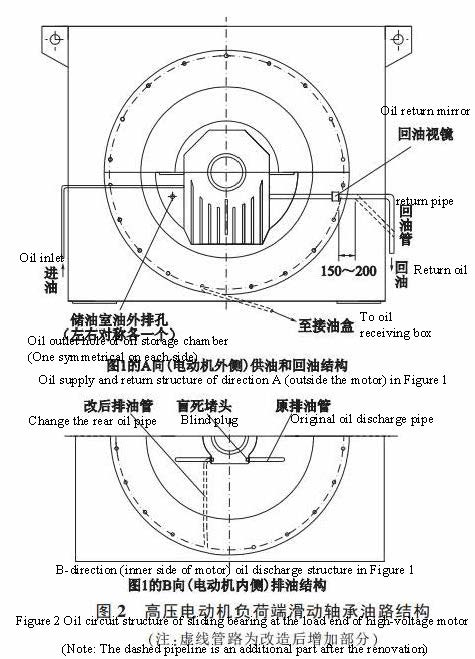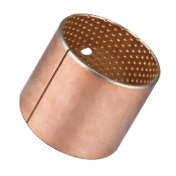In practical use, high-pressure motors with thin oil lubricated end cap sliding bearings often experience oil leakage even if the oil supply pressure is guaranteed to be within the manufacturer's specified range of 0.04-0.05MPa. This article takes our company's YBPKK710-81250kW high-voltage motor as an example to analyze the causes and solutions of motor bearing oil leakage.
1. Oil leakage phenomenon
Our company has a total of 7 10kV high-voltage motors lubricated with thin oil. During trial production, due to factors such as low motor alignment accuracy, uneven base, and motor magnetic center line not meeting technical requirements during installation, some of the motors have shaft displacement during operation. When the displacement exceeds the requirements, the metal friction between the end and shoulder of the bearing pads causes the temperature of the bearing pads to quickly rise to the trip protection temperature in a short period of time, resulting in equipment tripping. For this reason, the personnel in the position adopted the method of increasing the imported oil pressure to ensure production, but it subsequently caused the problem of bearing oil leakage. After a period of operation, the problem of motor shaft shifting was resolved by re aligning, verifying the base level, and adjusting the magnetic center line as required. The oil pressure returned to the required range of 0.04-0.05MPa, but the oil leakage problem continued, and the motor without shaft shifting gradually began to leak oil. In order to avoid the threat of oil leakage to the safe operation of the motor, it is necessary to take the opportunity to open the end cover and clean the internal oil stains of the motor during the cement kiln overhaul.
2 Oil leakage analysis
After multiple verifications and analyses, it is believed that the sealing structure design is generally reasonable, but due to some minor details, the oil leakage persists. The sealing of the motor bearing is shown in Figure 1. The floating seal inside the bearing chamber is composed of two semicircles, upper and lower, and there is an oil storage chamber between it and the oil felt seal. In theory, the oil leaked from the floating seal flows into the oil storage chamber and flows out from the oil drain hole on the lower end cover of the motor through the oil drain pipe. But the actual situation is that there is no oil flowing out of the oil drain hole. Every year when the machine is shut down and opened for inspection, there is a lot of oil in the inner cavity of the stator. Reasons for poor oil drainage:
1) The oil outlet of the oil storage chamber and the oil outlet of the motor end cover are at the same height and connected with rubber hoses. The joint is not tightly sealed. If the viscosity of the oil is high, it is difficult to flow out of the oil outlet pipe without pressure.
2) The lower half of the floating seal starts from the sliding bearing side, and only the labyrinth design has three oil return holes. When the oil pressure is high, the oil entering the labyrinth cannot return in time, and it will pass through the second to fourth labyrinths until entering the oil storage chamber. Moreover, due to incomplete pipeline cleaning and other reasons, the lubricating oil is contaminated. Due to the lack of oil return holes in the second to fourth labyrinths, the oil entering the labyrinth will accumulate for a long time, and the labyrinth will be filled with oil stains, making it ineffective in sealing. If the floating seal labyrinth is unobstructed and there is no micro positive pressure generated in the bearing chamber, there will be no oil leakage problem.
3) The installation of the oil return pipe is convenient. The horizontal distance behind the oil return mirror is too long (see Figure 2), and there is a slight upward movement of some pipes. The oil return is not smooth, and the oil level increases, causing the oil pressure in the bearing chamber to gradually change from zero to slightly positive pressure, causing oil leakage. Especially in winter, when starting up, due to the low temperature, high viscosity and poor fluidity of the oil, the phenomenon of oil leakage is particularly obvious.
3 Solutions
1) The second to fourth labyrinths of the floating seal are drilled three times according to the size of the labyrinth oil return holes (see Figure 1), ensuring that the oil entering the labyrinth can flow back smoothly.
2) The two oil discharge pipes in the original oil storage room were changed to one, blind to either side, and the other side was connected and sealed with a plastic hose. They were led out from the fixed screw hole at the lower end cover Z and connected to the oil box (see Figure 2) to prevent the oil from polluting the ground. The two original oil outlet holes on the original lower cover are blocked with fillers to ensure that the motor is sealed. Ensure that the oil return pipe in the horizontal section of the sliding bearing is level, and make an elbow at a distance of 150-200mm behind the oil return mirror to make the oil return pipe vertical or inclined downward, striving to have a steeper slope as much as possible to reduce the obstruction of oil return caused by the resistance of the oil return pipe.
4. Transformation effect
After taking the above measures, the oil leakage problem has been solved, and the safety hazards of motor operation have been eliminated. The practical inspection results are good. However, attention should still be paid during operation:
1) After a prolonged shutdown in winter, although the temperature of the oil tank is controlled at 25-40 ℃ when starting up, due to the long oil supply pipeline, the heat loss is large, and the low oil temperature leads to high viscosity of the oil entering the sliding bearing, poor oil return, and increased oil supply pressure, resulting in poor sealing effect. Therefore, insulation measures need to be taken for the oil supply pipeline.
2) When the oil supply pressure is normal during operation, once oil is found flowing out of the oil discharge pipe, it should be considered to check whether there is oil accumulation in the floating seal labyrinth and whether the oil return hole is blocked during shutdown. It is necessary to clean it in a timely manner.
More about Epen EMT Bushings:
EMT bi-metallic bushing is formed from steel strips with alloy lining material. The alloy lined surface can be machined oil grooves, holes, formed Indentations etc according to different application. It is suitable for high load, lower speed oscillation & rotation movement.
http://www.cnepen.com/showinfo-215-550-0.html





